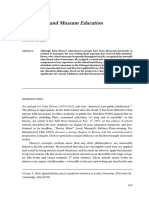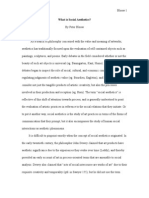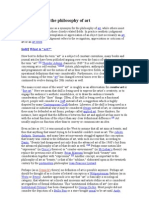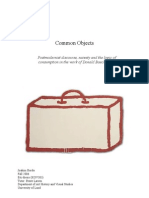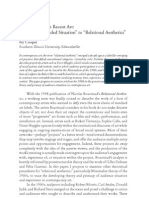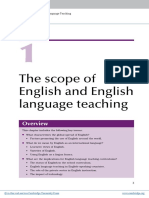100%(1)100% found this document useful (1 vote)
143 viewsKristina Lee Podesva A Pedagogical Turn Brief Notes On Education As Art
Kristina Lee Podesva A Pedagogical Turn Brief Notes On Education As Art
Uploaded by
grljadusThis summary provides an overview of the document in 3 sentences:
The document discusses Joseph Beuys' practice of using education and pedagogy as artistic mediums beginning in the 1970s. It examines how Beuys' performative lectures and installations laid the groundwork for later movements like institutional critique that also employed education and critique. While pioneering the use of education in art, Beuys' work also contained contradictions as he positioned himself as the singular authority even while advocating for participation and collaboration in art-making.
Copyright:
Attribution Non-Commercial (BY-NC)
Available Formats
Download as DOC, PDF, TXT or read online from Scribd
Kristina Lee Podesva A Pedagogical Turn Brief Notes On Education As Art
Kristina Lee Podesva A Pedagogical Turn Brief Notes On Education As Art
Uploaded by
grljadus100%(1)100% found this document useful (1 vote)
143 views7 pagesThis summary provides an overview of the document in 3 sentences:
The document discusses Joseph Beuys' practice of using education and pedagogy as artistic mediums beginning in the 1970s. It examines how Beuys' performative lectures and installations laid the groundwork for later movements like institutional critique that also employed education and critique. While pioneering the use of education in art, Beuys' work also contained contradictions as he positioned himself as the singular authority even while advocating for participation and collaboration in art-making.
Original Title
Kristina Lee Podesva a Pedagogical Turn Brief Notes on Education as Art
Copyright
© Attribution Non-Commercial (BY-NC)
Available Formats
DOC, PDF, TXT or read online from Scribd
Share this document
Did you find this document useful?
Is this content inappropriate?
This summary provides an overview of the document in 3 sentences:
The document discusses Joseph Beuys' practice of using education and pedagogy as artistic mediums beginning in the 1970s. It examines how Beuys' performative lectures and installations laid the groundwork for later movements like institutional critique that also employed education and critique. While pioneering the use of education in art, Beuys' work also contained contradictions as he positioned himself as the singular authority even while advocating for participation and collaboration in art-making.
Copyright:
Attribution Non-Commercial (BY-NC)
Available Formats
Download as DOC, PDF, TXT or read online from Scribd
Download as doc, pdf, or txt
100%(1)100% found this document useful (1 vote)
143 views7 pagesKristina Lee Podesva A Pedagogical Turn Brief Notes On Education As Art
Kristina Lee Podesva A Pedagogical Turn Brief Notes On Education As Art
Uploaded by
grljadusThis summary provides an overview of the document in 3 sentences:
The document discusses Joseph Beuys' practice of using education and pedagogy as artistic mediums beginning in the 1970s. It examines how Beuys' performative lectures and installations laid the groundwork for later movements like institutional critique that also employed education and critique. While pioneering the use of education in art, Beuys' work also contained contradictions as he positioned himself as the singular authority even while advocating for participation and collaboration in art-making.
Copyright:
Attribution Non-Commercial (BY-NC)
Available Formats
Download as DOC, PDF, TXT or read online from Scribd
Download as doc, pdf, or txt
You are on page 1of 7
Kristina Lee Podesva
A Pedagogical Turn: Brief Notes on Education as Art
Let us begin with the simple proposition that education as a form of art making
constitutes a relatively new medium. It is distinct from projects that take education and its
institution, the academy, as a subject or facilitator of production and is worth examining
in more detail through the following questions: How has the medium of education been
historically situated What movements and practices have conditioned its appearance
What does its circulation tell us about the academy—and art making—in the present And
finally, does the emergence of this medium represent a fad, or is it a manifestation of a
larger and more sustained “pedagogical turn” in contemporary art
Q: Why begin with questions Are they not containers for concealment, disguises for the
pre-determined, echoes of objectivity, apertures masking closures
A:
One of the most well known instances of education as a form of art appears in Joseph
Beuys’ practice beginning in the 1970s. While earlier efforts undertaken by the Russian
Constructivists, the Bauhaus, and the faculty of Black Mountain College, among others,
sought to erode the distinction between art and life through educational vehicles, they did
not appropriate pedagogical forms in their artistic production, using them instead as a
means to an end. By contrast, Beuys presented scores of educational lectures as
performances, documented in a series of photographs and blackboard drawings that
register the artists’ actions. Alain Borer has compared these “drawings” to the black
monochromes of both Kasimir Malevich and Ad Reinhardt, but makes an important
distinction, stating that Beuys’ monochromes form a larger and single “didactic
installation” characterized by a continuous temporality, which Beuys described as a
“permanent conference.” Thus, these performance-lectures were not temporally bounded
in a string of discrete, finite events, but were intended to prompt further discussions
carried out by the audience (post-performance) in a situation not unlike Documenta 5
(1972), where Beuys installed an office of the “Organization for Direct Democracy by
Referendum” to initiate conversations on a range of topics including politics and art.
These projects exemplify Social Sculpture, a concept and medium the artist devised and
later theorized in “I am Searching for Field Character” (1973), which articulates his belief
in the creative capacity of every in-dividual to shape society through participation in
cultural, political, and economic life. With his proclamation that “EVERY HUMAN
BEING IS AN ART-IST,” poised to join others in the construction of “A SOCIAL
ORGANISM AS A WORK OF ART,” Beuys reprised the fervor and axiomatic language
of manifestos written by avant-garde artists in the early twentieth century. This
promulgation expanded what art could be by acknowledging the viewer’s ability to co-
create meaning alongside the artist and, consequently, placed the production of art and
knowledge within the scope of the viewer just as much as that of the artist.
In practice, however, Beuys did not relinquish control of his productions so easily and
generously, alternately maintaining and mocking the authority invested in his position as
artist and as pedagogue. The Düsseldorf Academy of Art fired him in 1972 after he
opened his course to any student who wished to attend it, a direct violation of the
school’s admissions policy. The postcard multiple Demokratie ist lustig / Democracy is
Fun (1973) shows Beuys moments after his dismissal wearing an amused look and broad
grin on his face, flanked by uniformed policemen who stand as guarantors of a social
order in which free and open education is not permitted. Before, during, and after these
events, Beuys encouraged a series of protests at the school, and within the year he had
teamed up with writer Henrich Böll to co-found the Free International University for
Creativity and Interdisciplinary Research in Düsseldorf as an open forum and site for
democratic and creative study and expression.
What is striking about these events, like many of the actions Beuys performed, are the
paradoxes that underlie them. On the one hand, the artist sought to secure education and
equality for all. But on the other, this mission to democratize society hinged upon his
persona and insight, authorized by modernist beliefs in the sensitivity and sophistication
of the artist and teacher. As such, Beuys simultaneously challenged and reinforced the
patriarchal power structure of the academy and the authority of the artist; a benevolent
father he might have been, but a father he was nonetheless. Still, despite its many
contradictions, Beuys’ practice laid the groundwork for subsequent movements including
institutional critique and relational aesthetics, which have, in turn, revived education as
art.
The use of dematerialized mediums such as lectures, classes, and discussions may have
conditioned a shift from site-specific art making, in which particularized, physical space
was a paramount concern, to institutional critique, which expanded the notion of site to
include its sociological frames or institutional context. As Miwon Kwon has observed in
her essay “One Place after Another: Notes on Site Specificity,” for artists representative
of this shift, it was “the art institution’s techniques and effects as they circumscribe the
definition, production, presentation, and dissemination of art that [became] the site of
critical intervention.”“5 (read footnote)”:#note5 Thus, for Kwon, works in this genre
favour production that is less visual and material in nature both as a means to resist
commodification by the art institution, but also to interrogate the relationship between an
artwork and its location.
The performative and pedagogical inflection of Beuys’ art anticipated works of
institutional critique including Andrea Fraser’s Museum Highlights (1989) and Fred
Wilson’s Mining the Museum (1992). In the former, Fraser adopts the character of a
docent at the Philadelphia Museum of Art and is filmed leading unsuspecting visitors
through the museum on tours. What is uncovered by this performance-lecture is the
museum as an institution embedded within a skein of social, financial, and political
networks. Ultimately undermining the authority of the museum to determine what art is
and signifies, the work uses performance and education (in parodic disguise) as a form of
art making. As for the latter, Wilson rearranged museum displays at the Maryland
Historical Museum in Baltimore to arresting effect by articulating forgotten or untold
histories in a process of public re-education. He selected a set of silver goblets and a pair
of slave shackles from the museum’s collection storage and presented them together
under the title Metalwork, 1723-1880, bringing to light the politics of museological
practice and presentation in terms of repressing certain histories. Here, Wilson, like
Fraser, pries open the museum’s role in modeling our appreciation and understanding of
art as well as of history (or lack thereof) through performative and or pedagogical
strategies reminiscent of Beuys.
Q: What happens when questioning itself becomes the answer Can we run a concrete
course, over and over
A:
While institutional critique productively intersects with Beuys’ practice, it also shares
similar contradictions. We have already seen where Beuys’ performative and pedagogical
work is predicated on his supposedly unique ability to expose power. Museums and
galleries have subsequently recognized in artists such as Daniel Buren, Hans Haacke,
Fred Wilson, and Andrea Fraser, among others, a special aptitude for evaluating the
authoritative forms and functions of art institutions. They regularly invite these artists to
perform critiques that ostensibly disclose institutional machinations but do not go so far
as to propose redistributions of power. These works operate more on the level of
spectacle both during and also after the fact through photographs and films that record the
artist in full “critical” force. Consequently, institutions easily absorb projects of
institutional critique demonstrating how little purchase these assessments have in the long
run. Assuming the position of critic, artists working in this genre also privilege their
perspectives over others, making their work entirely contingent upon specific targets,
which they have selected alone and in close consultation with museums and galleries. In
Beuys’ work, the problem does not revolve so much around his spectacularization of
criticism, but rather that he presented himself as having a singular insight into what issues
deserved our attention, whether that was direct democracy or free education. Nonetheless,
he did invite people to participate in his performances, with or without the agreement of
institutions (educational, artistic, or otherwise), to co-create meaning and to address the
issues he found pressing. In many ways, Beuys’ legitimization of collaboration and
interaction as a means of making art is foundational to relational aesthetics.
First conceptualized by Nicholas Bourriaud in 1998, relational aesthetics has categorized
a number of practices that came to prominence in the 1990s. Claire Bishop observes that
these practices tend to involve hybrid installations in which the audience is invited to
engage in some form of activity that defines a space reserved for relating socially. For
Bishop, artists who work with relational aesthetics, such as Rirkrit Tiravanija and Liam
Gillick, offer a “microtopian ethos” in lieu of “utopian propositions,” where the space of
the gallery delimits a social setting in which viewers co-produce the meaning of the
work. By way of example, a gallery expresses a microtopian ethos when an artist re-
purposes it as a site of refuge from the real world (even though he or she attempts to
recreate social interactions there typically associated with existing places such as the pub
or community centre). In this way, this work does not encourage us to strive for a larger
utopian goal—such as securing permanent and free communal space—but rather to sit
back and enjoy, in whatever way we can, the here and now offered by the artist courtesy
of the gallery.
Tiravanija’s Untitled (1992) represents one early and illustrious example of relational
aesthetics. The artist moved the entire inventory of Gallery 303 in New York into its
exhibition rooms and then converted the storage and office areas into a provisional
kitchen where he made Thai curries for visitors during regular business hours. Traces of
his actions remained on display at the gallery when he was absent. Yet, for Tiravanija, the
art does not reside in the actions shown, but in what they facilitate: “a convivial
relationship between audience and artist.”“8 (read footnote)”:#note8 Like Beuys’ work
dealing with education, relational projects such as Untitled foreground conversations and
experiences among viewers, recognizing their participation in the co-creation of meaning
through the experience of an artwork. Unlike Beuys, however, artists working in this
genre do not hold out the promise of “FREE DEMOCRATIC SOCIALISM,” nor do they
antagonize the site of their work as an institution. Instead, they strategically recast the
gallery as a microtopian site for relating, which stops short of addressing the politics
behind the shrinking of free social space in the world today. By emphasizing the social
dimensions of contemporary life, practices of relational aesthetics appear to neglect how
the social is imbricated in the political and the economic.
Extending the creative and democratic imaginary Beuys developed through Social
Sculpture, artists who appropriate education as a medium for art making whether in the
form of a school, knowledge exchanges, reading groups, lectures, laboratories, and so on,
could be seen as a subset of practices that treat site specificity more broadly. Kwon
observes that in the period since institutional critique (from the 1970s onward) artists
have turned away from the art institution toward more quotidian spaces such as the street,
stores, homes, and schools as possible sites of engagement. She concludes that the
“distinguishing characteristic of today’s site-oriented art is the way in which the
artwork’s relationship to the actuality of a location (as site) and the social conditions of
the institutional frame (as site) are both subordinate to a discursively determined site that
is delineated as a field of knowledge, intellectual exchange, or cultural debate,” which
does not exist a priori, but is generated through the work itself.
Q: What does it mean when we accept answers without asking questions Is it like being
given a life jacket in exchange for your sailboat
A:
Perhaps even more than the museum, then, the academy, as a site of cultural knowledge
production par excellence provides a compelling space for further interrogation. The art
world’s growing interest in the academy is not unique. Within the last two decades,
neoliberal ideology has increasingly restructured the academy according to its goals and
priorities into, according to David Harvey, a theoretical program of “political economic
practices that proposes that human well-being can best be advanced by liberating
individual entrepreneurial freedoms and skills within an institutional framework
characterized by strong private property rights, free markets and free trade.”“12 (read
footnote)”:#note12 Besides privatization, neoliberalism has also systematized academic
work such that knowledge production operates according to market logic where
patentability, utility, and quantitative methods are valued over collaborative, speculative,
and qualitative approaches. The inevitable outcome to this hierarchical arrangement is
that critical experimentation is discouraged, or worse, rendered obsolete.
Harvey identifies the academy as an important component in the “construction of
consent,” a process in which the once fringe ideology of neoliberalism became
mainstreamed in the United States, at a micro level, through established institutions such
as schools, universities, and churches. This ideology spread because it presented in quite
logical and natural terms the sanctity of individual rights and the universal value of
democracy. In fact, it legitimated the free market by collapsing the discourse of
individual rights with the idea that corporations are individuals entitled to the same
inalienable rights. At the macro level, several primary vehicles such as the courts, the
media, and, finally, the academy have helped to not only disseminate, but shape
neoliberal values. Conservative think tanks (research groups sited on university campuses
to formulate strategies for achieving social and political aims) provide one solid example
of how the culture of consent operates. Increasing in numbers since the 1970s, think tanks
have become the de facto “educational arm” of the corporations that fund them.
In her essay “Academy as Potentiality,” Irit Rogoff draws attention to the changing
priorities of the academy and proposes an alternative to its corporatization through the
adoption of research and knowledge projects that privilege what is significant over what
is useful. She introduces the concept of potentiality (and fallibility) as a way of re-
thinking and re-making the academy as a space for speculation and experimentation
rather than the manufacture of knowledge products. Rogoff and other academics
throughout Europe feel threatened by the Bologna Accord, which proposes to standardize
all institutions and programs of higher education within the European Union by 2010
such that degree programs across all disciplines will be interchangeable and uniform
following North American models. According to Stephan Dillemuth, the Bologna Accord
emerged out of research developed by the Centre for Higher Education, a think tank
founded in 1995 by the Bertelsmann Corporation, a worldwide media conglomerate, with
interests in creating new markets for media products and, no doubt, a culture of consent.
It would be too easy to blame the neoliberal agenda for the academy’s current
corporatization, however, particularly in regard to the education of the artist. Although it
would appear that neoliberalism has made “The MFA the New MBA” in the 2004
Harvard Business Review article by Daniel Pink, it is the various arts institutions that
grant MFAs as a professional degree for tens of thousands of dollars a year that are first
and foremost responsible for this equivalence. As Okwui Enwezor has pointed out, this
scenario renders the MFA as “useless” as the MBA in respect to the production of
meaning in art.17”17 (read footnote)”:#note17
Q: _When there are no spaces for questioning, where do questions go Do they
accumulate in the exchanges between people, remain hushed in dusty cabinets, or
dissolve like ash in a cold spray _
A:
It is into this current milieu that education as art is being reborn. Taking from the earlier
precedent of Beuys’ work with the academy as an authoritative institution, these new
works, including projects such as the Copenhagen Free University (founded in 2001),
Playshop (2004), the Momentary Academy (2005), and the School of Panamerican
Unrest (2006-2007), to name a few, trade the wisdom and charisma of a Beuysian figure
for a collaborative and contemporary set of learning experiences and exchanges. Like
many projects associated with institutional critique, these works engage with the academy
as an institution, and are located discursively (but not necessarily physically) within the
site of the academy. At the same time, they sidestep the closures of critiques, which
narrowly focus on institutional failures, offering instead to open up the academy through
reinvention.
In 2001, for example, Danish artists Henriette Heise and Jakob Jakobsen founded the
Copenhagen Free University (CFU) in their apartment and began to offer a free space and
online resource “dedicated to the production of critical consciousness and poetic
language.”“19 (read footnote)”:#note19 The CFU’s website contains numerous critical
theory texts in Danish and English, a web library with supplementary texts, links to
affiliated organizations around the world, and a few digital artworks including 17 Theses
on Knowledge Production, which features scrolling statements such as the following:
Echoing Vladimir Tatlin’s exuberant appeal for an “art into life,” the idea of turning
knowledge into life (and relocating knowledge from the ivory tower to those spaces
occupied in the everyday) is only one of many redefinitions at work in this project. The
CFU re-imagines the form and function of art making, knowledge production (and by
extension the academy), and authorship (collaborative versus autonomous). Moreover, it
attempts to dissolve the barrier between the public and private by siting educational
activities in a residential space. Rather than limiting its exploration to critique, it creates a
working alternative to stale and outmoded practices of artistic and intellectual production.
From my research into art projects that take educational forms as their medium, I have
observed in the CFU and other works shared concerns and characteristics, which include
the following:
1. A school structure that operates as a social medium.
2. A dependence on collaborative production.
3. A tendency toward process (versus object) based production.
4. An aleatory or open nature.
5. An ongoing and potentially endless temporality.
6. A free space for learning.
7. A post-hierarchical learning environment where there are no teachers, just co-
participants.
8. A preference for exploratory, experimental, and multi-disciplinary approaches to
knowledge production.
9. An awareness of the instrumentalization of the academy.
10. A virtual space for the communication and distribution of ideas.
Nearly twenty years ago, Ian Wallace wrote “The Idea of the University,” an essay that
discusses how the image and function of art and the university will always fall short of
our expectations since they are both falsely idealized. Although we may come to
understand how our perception of the truth-telling power of both art and the university
(and by extension the academy and education) is illusory and derives from specific rather
than universal values, we do not and cannot seem to abandon either ideal, adopting
instead reformist (in the better case) or resigned (in the worse case) approaches to
achieving their promise. It is, perhaps, through education as a form of art making that we
do not settle for better or for worse.
About this Article
A Pedagogical Turn: Brief Notes on Education as Art was first published in Fillip 6 in
Summer 2007. For more articles from this issue, see the Table of Contents.
Kristina Lee Podesva is Assistant Editor of The Fillip Review.
Notes
1. Other notable instances include Robert Filliou and John Cage’s discussion in
Teaching and Learning as Performance Arts from 1970 and Iain Baxter’s
teaching performances, which he began in the late 1960s. ←
2. Alain Borer, “A Lament for Joseph Beuys,” The Essential Joseph Beuys, ed.
Lothar Schirmer (Cambridge, MA: MIT Press, 1997), 14. ←
3. Joseph Beuys, “I am Searching for Field Character,” Participation, ed. Claire
Bishop (London: Whitechapel, 2006), 125. ←
4. The Free International University for Creativity and Interdisciplinary Research
continues to exist in various chapters worldwide. ←
5. Miwon Kwon, “One Place After Another: Notes on Site Specificity,” October
(Spring 1997): 37. ←
6. Andrea Fraser has declared that artists are now the embodiment of the institution
and that institutional critique is in fact dead. See “From the Critique of Institutions
to an Institution of Critique,” Artforum (September 2005): 278–283. ←
7. Claire Bishop, “Antagonism and Relational Aesthetics,” October (Fall 2004): 54.
←
8. Ibid., 56. ←
9. Beuys, 125. ←
10. Kwon, 37–8. ←
11. This is demonstrated in Documenta 12’s final leitmotif, exhibitions such as
A.C.A.D.E.M.Y (2005–2006), and projects like unitednationsplaza (2006—2007)
to name a few. ←
12. David Harvey, A Brief History of Neoliberalism (New York: Oxford University
Press, 2005),2. ←
13. Ibid., 39. # Ibid., 43–44. ←
14. Irit Rogoff, “Academy as Potentiality,” A.C.A.D.E.M.Y (Frankfurt am Main:
Revolver, 2006), 14. ←
15. Stephan Dillemuth, “Schools of Thought,” Frieze (September 2006): 144. ←
16. Okwui Enwezor, “Schools of Thought,” Frieze (September 2006): 143. ←
17. For a longer list of education as art projects, see Joseph del Pesco’s Edu-Projects
page at http://www.delpesco.com/blog/archives/edu-projects/. ←
18. Henriette Heise and Jakob Jakobsen, Copenhagen Free University Information:
_http://www.copenhagenfreeuniversity.dk/infouk.html _(accessed 1 November
2006). ←
19. Henriette Heise and Jakob Jakobsen, Copenhagen Free University Information,
17 Theses on Knowledge Production:
http://www.copenhagenfreeuniversity.dk/theses.html (accessed 1 November
2006). ←
20. Ian Wallace, “The Idea of the University,” The Idea of the University (Vancouver:
University of British Columbia Fine Arts Gallery, 1990).
You might also like
- How to Do Things with Art: The Meaning of Art's PerformativityFrom EverandHow to Do Things with Art: The Meaning of Art's PerformativityRating: 4.5 out of 5 stars4.5/5 (2)
- What is Art?: Conversation with Joseph BeuysFrom EverandWhat is Art?: Conversation with Joseph BeuysRating: 3.5 out of 5 stars3.5/5 (5)
- Aesthetics (Key Concepts in Philosophy) - Daniel HerwitzDocument200 pagesAesthetics (Key Concepts in Philosophy) - Daniel HerwitzTeodor Alexandru88% (16)
- Stuart Hall Culture Media and The Ideological EffectDocument18 pagesStuart Hall Culture Media and The Ideological Effectgrljadus100% (4)
- Visual Culture: Norman Bryson, Michael Ann Holly, Keith MoxeyDocument19 pagesVisual Culture: Norman Bryson, Michael Ann Holly, Keith MoxeyJames ConnahNo ratings yet
- ATKISON, Dennis. Contemporary Art and Art Education ARTIGODocument14 pagesATKISON, Dennis. Contemporary Art and Art Education ARTIGOCristian ReichertNo ratings yet
- Maria Lind Why Mediate ArtDocument17 pagesMaria Lind Why Mediate ArtPavlovsky GonzálezNo ratings yet
- Hantelmann SocioPoliticsexhibitionDocument13 pagesHantelmann SocioPoliticsexhibitionValeriaTellezNiemeyerNo ratings yet
- Suzana Milevska Participatory Art 2013Document10 pagesSuzana Milevska Participatory Art 2013Suzana MilevskaNo ratings yet
- Louis Althusser - The Only Materialist Tradition (Spinoza)Document9 pagesLouis Althusser - The Only Materialist Tradition (Spinoza)grljadusNo ratings yet
- Milder - Teaching As ArtDocument15 pagesMilder - Teaching As ArtAnonymous QcIEvhWCNo ratings yet
- John Dewey and Museum EducationDocument15 pagesJohn Dewey and Museum EducationJoão Paulo AndradeNo ratings yet
- What Is Social AestheticsDocument8 pagesWhat Is Social AestheticsStefan BlomqvistNo ratings yet
- Joseph Beuys Life Course Work CourseDocument5 pagesJoseph Beuys Life Course Work Coursehggrgljbf67% (3)
- Beuys Life Course Work CourseDocument4 pagesBeuys Life Course Work Coursefrebulnfg100% (2)
- Presence of ArtDocument10 pagesPresence of Artmiaburgener123No ratings yet
- Mary Coffey, Introduction: How A Revolutionary Art Became Official CultureDocument24 pagesMary Coffey, Introduction: How A Revolutionary Art Became Official Culturemichael ballNo ratings yet
- Phillips 2021 The Issue Is Moot Decolonizing Art ArtifactDocument23 pagesPhillips 2021 The Issue Is Moot Decolonizing Art ArtifactMelina SantosNo ratings yet
- Subversive SignsDocument5 pagesSubversive SignsFernando García100% (1)
- The Role of The Artist As A Social Critic - As Interpreted Through The ArtDocument94 pagesThe Role of The Artist As A Social Critic - As Interpreted Through The Artpatrik sarekozyNo ratings yet
- Constructing A Sociology For An Icon of Aesthetic Modernity - Olympia Revisited (Robert W. Witkin)Document26 pagesConstructing A Sociology For An Icon of Aesthetic Modernity - Olympia Revisited (Robert W. Witkin)Kenneth AllinsonNo ratings yet
- Burton Joanna Cultural InferenceDocument6 pagesBurton Joanna Cultural InferenceDavid WeldziusNo ratings yet
- C.bishop Pawel AlthamerDocument5 pagesC.bishop Pawel AlthamerbertanivulatNo ratings yet
- Group Material Abstraction As The Onset of The Real Transversal TextsDocument23 pagesGroup Material Abstraction As The Onset of The Real Transversal TextsYeonjung LeeNo ratings yet
- Beyond The Head - The Practical Work of Curating Contemporary ArtDocument21 pagesBeyond The Head - The Practical Work of Curating Contemporary ArtCristine CarvalhoNo ratings yet
- Contemporary Debates in Art FinalDocument14 pagesContemporary Debates in Art Finalnf4660123No ratings yet
- Beyond Institutional CritiqueDocument14 pagesBeyond Institutional CritiqueCesar Garcia OrtizNo ratings yet
- Maria Lind Why Mediate ArtDocument17 pagesMaria Lind Why Mediate Artdenisebandeira100% (6)
- Education After Art A Review PDFDocument6 pagesEducation After Art A Review PDFHilda Helinä SnellmanNo ratings yet
- Marx and IdeologyDocument3 pagesMarx and IdeologyhiNo ratings yet
- Aesthetics and The Philosophy of ArtDocument3 pagesAesthetics and The Philosophy of ArtRenzo Pittaluga100% (1)
- D. Atkinson What Is Art in Education New Narratives of LearningDocument12 pagesD. Atkinson What Is Art in Education New Narratives of LearningCristiano de SousaNo ratings yet
- J.borda - Ba ThesisDocument28 pagesJ.borda - Ba ThesisCecilia BarretoNo ratings yet
- The New Sociology of Art': Putting Art Back Into Social Science Approaches To The ArtsDocument17 pagesThe New Sociology of Art': Putting Art Back Into Social Science Approaches To The ArtsigorNo ratings yet
- Week 13 Contemporary ArtDocument4 pagesWeek 13 Contemporary ArtJade CarbonNo ratings yet
- Cooper, IvyDocument11 pagesCooper, IvyMarshall BergNo ratings yet
- 1-Artigo - CLEMENTS, Alexis - Reconsidering John Dewey's Art As ExperienceDocument12 pages1-Artigo - CLEMENTS, Alexis - Reconsidering John Dewey's Art As ExperiencekarithaNo ratings yet
- After AllDocument139 pagesAfter Allemprex100% (3)
- Pellegrini, Puar. Affect (P. 35-38) (2009)Document38 pagesPellegrini, Puar. Affect (P. 35-38) (2009)Marco Antonio Gavério100% (1)
- Museum As Interactive SpaceDocument29 pagesMuseum As Interactive SpaceUshna Sabir100% (1)
- Conversation+Pieces +the+Role+of+Dialogue+in+Socially Engaged+ArtDocument16 pagesConversation+Pieces +the+Role+of+Dialogue+in+Socially Engaged+ArtAbdelaziz Zuñiga LopezNo ratings yet
- De La Fuente - The New Sociology of ArtDocument18 pagesDe La Fuente - The New Sociology of ArtEdoardo FracanzaniNo ratings yet
- Conversation PiecesGKester PDFDocument10 pagesConversation PiecesGKester PDFCulturadelacopiaNo ratings yet
- Aesthetics - Key Concepts in Philosophy - Daniel Herwitz - Key Concepts in Philosophy, 2008 - Continuum - 9780826489197 - Anna's ArchiveDocument194 pagesAesthetics - Key Concepts in Philosophy - Daniel Herwitz - Key Concepts in Philosophy, 2008 - Continuum - 9780826489197 - Anna's Archive林顯力No ratings yet
- Eszter Lázár - Educational TurnDocument7 pagesEszter Lázár - Educational TurnFermín SoriaNo ratings yet
- OFS - Fluxus - Thinking About TimeDocument10 pagesOFS - Fluxus - Thinking About Timedr.fluxNo ratings yet
- Ace Art Appreciation (Week 7-9) - HighlightedDocument9 pagesAce Art Appreciation (Week 7-9) - Highlightedtubig.justineace.stem201No ratings yet
- DeleuzeDocument27 pagesDeleuzeAliaa Ahmed ShemariNo ratings yet
- Chapter5 PDFDocument32 pagesChapter5 PDFKinshiro ShimuraNo ratings yet
- Essay Conceptual Art - Joseph KosuthDocument6 pagesEssay Conceptual Art - Joseph KosuthNicoletta UnghiattiNo ratings yet
- Vygotsky's Sociocultural TheoryDocument17 pagesVygotsky's Sociocultural TheoryPGIndikaNo ratings yet
- University of Illinois Press The Journal of Aesthetic EducationDocument13 pagesUniversity of Illinois Press The Journal of Aesthetic EducationBarbara KanashiroNo ratings yet
- Positively White Cube RevisitedDocument4 pagesPositively White Cube RevisitedeleendeprezNo ratings yet
- What Is A Curator - Claire BishopDocument8 pagesWhat Is A Curator - Claire BishopFelipe Castelo BrancoNo ratings yet
- Mediareview Education After Art: A Review of Letting Art Teach: Art Education After Joseph BeuysDocument5 pagesMediareview Education After Art: A Review of Letting Art Teach: Art Education After Joseph BeuyskathrynNo ratings yet
- Embodying Art The Spectator and The Inner BodyDocument36 pagesEmbodying Art The Spectator and The Inner BodyEva VápenkováNo ratings yet
- Modern and Contemporary ArtDocument5 pagesModern and Contemporary ArtMARLA JOY LUCERNANo ratings yet
- Artificial Hells: Participatory Art and the Politics of SpectatorshipFrom EverandArtificial Hells: Participatory Art and the Politics of SpectatorshipRating: 4.5 out of 5 stars4.5/5 (10)
- Fraser Introduction 2018Document7 pagesFraser Introduction 2018madhu smritiNo ratings yet
- A New Thoughtfulness in Contemporary China: Critical Voices in Art and AestheticsFrom EverandA New Thoughtfulness in Contemporary China: Critical Voices in Art and AestheticsJörg HuberNo ratings yet
- Emmanuel Terray An Encounter Althusser and MachiavelliDocument21 pagesEmmanuel Terray An Encounter Althusser and MachiavelligrljadusNo ratings yet
- Althusser - Can Everyone Be A PhilosopherDocument4 pagesAlthusser - Can Everyone Be A PhilosophergrljadusNo ratings yet
- Culp - Structural Causality in Freud and Althusser - BelDocument23 pagesCulp - Structural Causality in Freud and Althusser - BelgrljadusNo ratings yet
- Althusser - On The Primacy of The Relations of ProductionDocument9 pagesAlthusser - On The Primacy of The Relations of ProductiongrljadusNo ratings yet
- Agonhamza PDFDocument15 pagesAgonhamza PDFgrljadusNo ratings yet
- Godard and Gorin's Left Politics by Julia LesageDocument25 pagesGodard and Gorin's Left Politics by Julia LesagegrljadusNo ratings yet
- Boer - Althusser's Catholic MarxismDocument19 pagesBoer - Althusser's Catholic MarxismgrljadusNo ratings yet
- Godard - What Is To Be DoneDocument2 pagesGodard - What Is To Be DonegrljadusNo ratings yet
- Radical Philosophy 170 - The Althusser-Rancière Controversy DossierDocument28 pagesRadical Philosophy 170 - The Althusser-Rancière Controversy Dossiergrljadus100% (1)
- Gregory Elliott (Editor) - Althusser: A Critical Reader (1994)Document116 pagesGregory Elliott (Editor) - Althusser: A Critical Reader (1994)grljadusNo ratings yet
- Poster On Visual StudiesDocument4 pagesPoster On Visual StudiesgrljadusNo ratings yet
- Learning Activity - Module 9 - LeadershipDocument3 pagesLearning Activity - Module 9 - LeadershipDorothy Yvonne LorenteNo ratings yet
- Online Registration System Sample ThesisDocument8 pagesOnline Registration System Sample ThesisArlene Smith100% (2)
- Chavez JuuliDocument40 pagesChavez JuuliSameera JayaratneNo ratings yet
- AnnotationsDocument3 pagesAnnotationsapi-598459155No ratings yet
- Class DownshiftingDocument14 pagesClass DownshiftingJessica JuarezNo ratings yet
- Result of SSC or Equivalent Examination - 2023: Subject-Wise Grade/MarksDocument1 pageResult of SSC or Equivalent Examination - 2023: Subject-Wise Grade/Marksmisbahulalam78No ratings yet
- Ips 331 Class NotesDocument5 pagesIps 331 Class NotesAnathi ManyabaNo ratings yet
- ISO-56001-2024Document11 pagesISO-56001-2024Baghdadi RaniaNo ratings yet
- Ubc 2009 Fall Shason Jan-PaulDocument154 pagesUbc 2009 Fall Shason Jan-PaulNiña Anne DelaCruz RamosNo ratings yet
- PMCF Summary Quarter 1 2023-2024Document2 pagesPMCF Summary Quarter 1 2023-2024Jean Rose Palacio100% (2)
- Mon Enfance Project Rubric Checklist 2017Document2 pagesMon Enfance Project Rubric Checklist 2017api-261181520No ratings yet
- Cultures and SubculturesDocument22 pagesCultures and SubculturesTheo CassNo ratings yet
- Brian Tracy - Notes On Power Reading and WritingDocument4 pagesBrian Tracy - Notes On Power Reading and WritingAncuta Petre100% (2)
- Kenya Relief Grant ProposalDocument31 pagesKenya Relief Grant ProposalgyrichardNo ratings yet
- Chess For Success Using An Old Game To Build New Strengths in Children and Teens by Maurice AshleyDocument270 pagesChess For Success Using An Old Game To Build New Strengths in Children and Teens by Maurice AshleyGABRIEL COCA MERIDANo ratings yet
- Arranging 1: Rhythm Section - SyllabusDocument2 pagesArranging 1: Rhythm Section - SyllabusGamal AsaadNo ratings yet
- Course Start Instructor Task Lists Checklist Blackboard Updated 04-17-14Document2 pagesCourse Start Instructor Task Lists Checklist Blackboard Updated 04-17-14api-253788866No ratings yet
- KEL.6 KTI - Siti Efi Mufidah (2003016113) and Laila Sukma Amalia (2003016090)Document4 pagesKEL.6 KTI - Siti Efi Mufidah (2003016113) and Laila Sukma Amalia (2003016090)EfiNo ratings yet
- Chapter 3 Unit 6 - Organizational CultureDocument32 pagesChapter 3 Unit 6 - Organizational Culturelinhhoangg23072004No ratings yet
- 30-3-1 (Mathematics Standard)Document24 pages30-3-1 (Mathematics Standard)utkarshastronaut2468No ratings yet
- PrefixDocument2 pagesPrefixMaureen Tianson DomingoNo ratings yet
- Ideas For Implementing The Seven Dimensions of Wellness: Presented by Donna Martz & Annika CollinsDocument34 pagesIdeas For Implementing The Seven Dimensions of Wellness: Presented by Donna Martz & Annika CollinsMillerJamesDNo ratings yet
- Extra Grammar Exercises (Unit 3, Page 21) : Top Notch Fundamentals, Third EditionDocument3 pagesExtra Grammar Exercises (Unit 3, Page 21) : Top Notch Fundamentals, Third EditionAngel SuarezNo ratings yet
- The Scope of English and English Language Teaching PDFDocument7 pagesThe Scope of English and English Language Teaching PDFanurajbhorkiNo ratings yet
- Understanding The LearnersDocument9 pagesUnderstanding The LearnersNicole RomeroNo ratings yet
- 10th Roll Nos.Document2 pages10th Roll Nos.Nityanand JenaNo ratings yet
- Course Outline SociolinguisticsDocument3 pagesCourse Outline SociolinguisticsDeniz Gul GüzelNo ratings yet
- Codes: DiglossiaDocument2 pagesCodes: DiglossiaNikai Hermawan AmrullahNo ratings yet
- Sanmar BringtogetherneighborhoodDocument4 pagesSanmar Bringtogetherneighborhoodapi-285755865No ratings yet
- #4 Case Study Panama PDFDocument10 pages#4 Case Study Panama PDFAnne AnsulaNo ratings yet











